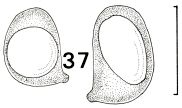|
 Clavaria sp. 3 Clavaria sp. 3
BiostatusPresent in region - Indigenous
Images (click to enlarge)
Caption: Fig. 37 Clavaria Taxon no. 3, spores. TENN no. 43584. Scale bar = 5 µm |
Article: Petersen, R.H. (1988). The clavarioid fungi of New Zealand. New Zealand Department of Scientific and Industrial Research, Bulletin 236: 170 pp. Wellington:.
Description: Fruit bodies up 40 x 2 mm, simple clubs, narrowly cylindrical, pure white all over. Stipe
pinched and minutely pruinose at the base, terete, appearing silky. Club appearing waxy,
terete; apex rounded. Taste and odour negligible.
Tramal hyphae of club 2-6 µm diam., hyaline, clampless, parallel, tightly packed.
Subhymenium extensive, pseudoparenchymatous. Hymenium thickening; basidia 50-55 x 7-8 µm, narrowly clavate, bifurcate to clamped at base;
persistent after spore discharge;
contents sparsely multiguttulate at maturity; sterigmata 4, up to 6 µm long, slender, curved-erect.
Spores (Fig. 37) 4.3-5.4 x 3.2-3.6 µm (E= 1.33-1.67; Em = 1.50; Lm = 5.08 µm), narrowly
ovate to ellipsoid, flattened adaxially, hyaline, smooth, thin-walled; contents multiguttulate when mature; hilar appendix papillate.
Notes: with a sole specimen, almost no notes and no photograph, I do not have enough material on
which to propose a new taxon, but I do not know a name for the specimen. It certainly is
analogous to Clavaria subacuta (as treated here) except for the clamped basidia. I have
followed Corner (1950) for a concept of C. subacuta, however, including clampless basidia, and without examining the type specimen,
I would not want to be more precise.
Otherwise, these pure white fruit bodies are so similar to those of Clavaria acuta and some collections of C. gibbsiae and
C. redoleo-alii that they are indistinguishable from one
another. Spore shape will segregate Taxon no. 3 from the others; odour separates it from C.
redoleo-alii and spore ornamentation from C. gibbsiae.
|